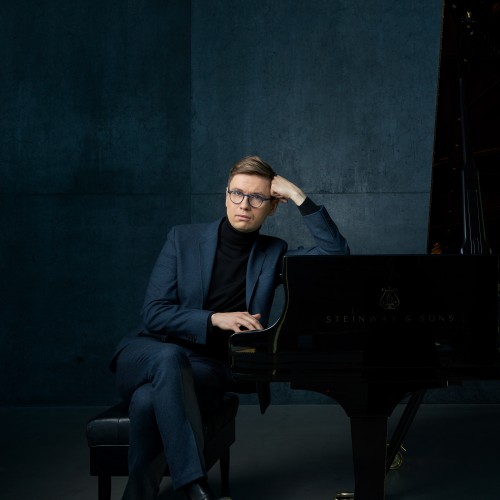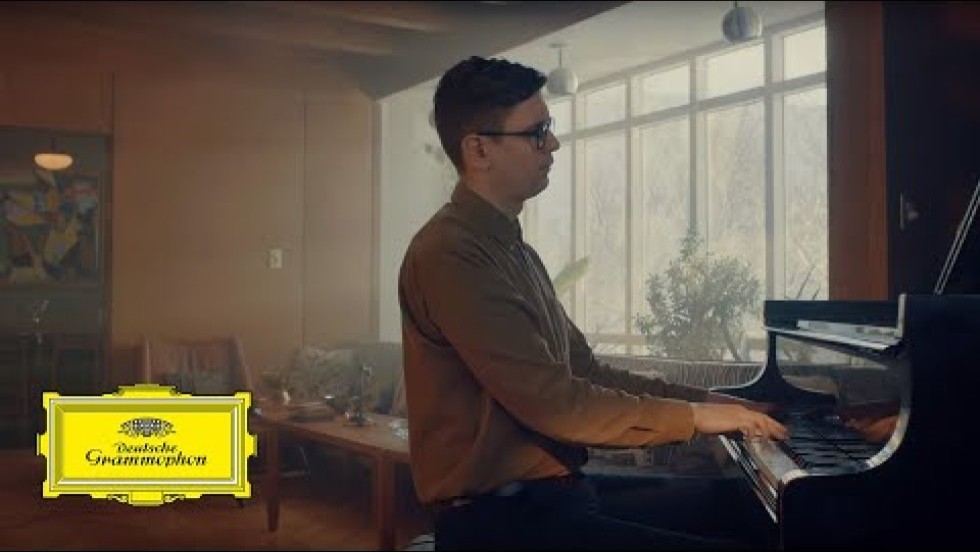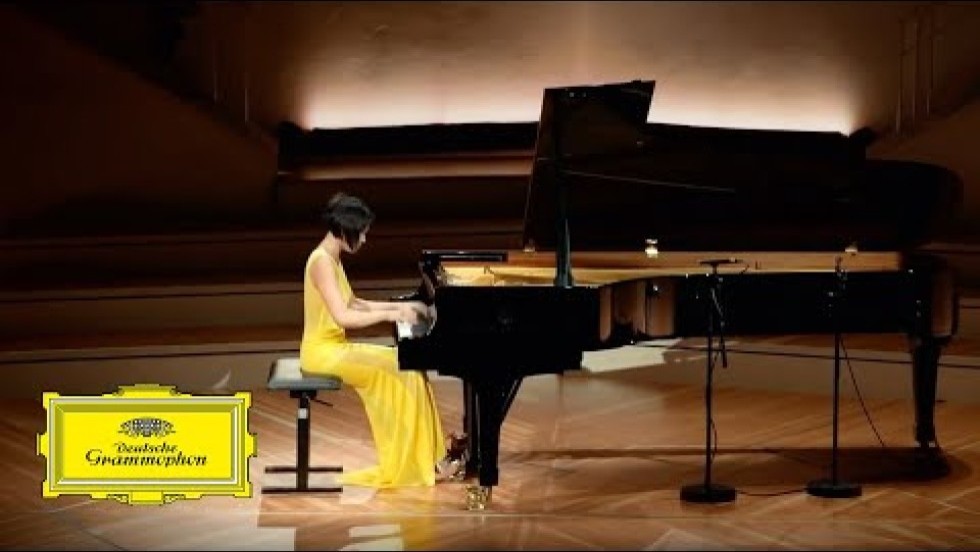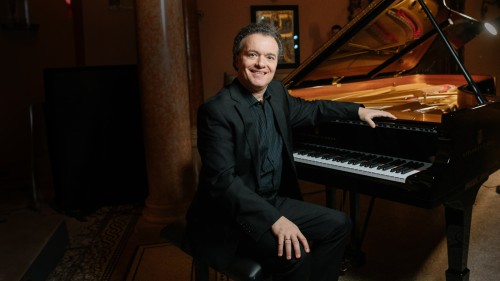
Víkingur Ólafsson, piano
Yuja Wang, piano
Duo piano / piano four hands
Cookie Notice
This site uses cookies to measure our traffic and improve your experience. By clicking "OK" you consent to our use of cookies.
Pianists Víkingur Ólafsson and Yuja Wang have consistently wowed audiences as solo recitalists, chamber music partners, and orchestral soloists. This season, they come together on Symphony Hall’s stage for a two-piano and piano four hands recital featuring Rachmaninoff’s Symphonic Dances, John Adams’ Hallelujah Junction, and more.
In recent seasons, Icelandic pianist Ólafsson has left Series audiences awestruck thanks to his prolific and captivating performance style. Awarded her first Grammy in 2024 for Best Classical Instrumental Solo, Wang’s unstoppable rise within the classical music world is a testament to her dazzling skill and charisma. Ólafsson and Wang are sure to deliver an unforgettable experience: illuminating, surprising, and joyful.
Program Details
Luciano Berio (1925-2003) was one of the great avant-garde composers of the 20th century. To many, this is a euphemism for “inaccessible.” But Berio, along with Stravinsky, was perhaps the greatest composer of pastiche in the same era. He was not beholden to any particular compositional dogma exclusively and his startling technique and imagination made it so he could effortlessly write in any style he felt like paying homage to. Nowhere is that clearer than in his little encore pieces, to which his Wasserklavier (water piano) belongs.
The piece is essentially an ode to late Romantic piano music and is especially reminiscent of late Brahms. It unfolds with a cascading texture of gently flowing arpeggios, evoking rippling water. The notes shimmer delicately, each figure melting into the next almost imperceptibly. The music never rises above a whisper, gently drawing the listener into its intimate, dreamlike world. Berio’s harmonic language is rooted in the past but possesses a core of subtly dissonant modernism that makes the piece shimmer. It is hypnotic and undeniably beautiful, showcasing Berio at his playful best.
© Connor Buckley, 2025
Luciano Berio (1925-2003) was one of the great avant-garde composers of the 20th century. To many, this is a euphemism for “inaccessible.” But Berio, along with Stravinsky, was perhaps the greatest composer of pastiche in the same era. He was not beholden to any particular compositional dogma exclusively and his startling technique and imagination made it so he could effortlessly write in any style he felt like paying homage to. Nowhere is that clearer than in his little encore pieces, to which his Wasserklavier (water piano) belongs.
The piece is essentially an ode to late Romantic piano music and is especially reminiscent of late Brahms. It unfolds with a cascading texture of gently flowing arpeggios, evoking rippling water. The notes shimmer delicately, each figure melting into the next almost imperceptibly. The music never rises above a whisper, gently drawing the listener into its intimate, dreamlike world. Berio’s harmonic language is rooted in the past but possesses a core of subtly dissonant modernism that makes the piece shimmer. It is hypnotic and undeniably beautiful, showcasing Berio at his playful best.
© Connor Buckley, 2025
Composed in the final year of his tragically short life, Franz Schubert (1797-1828)’s Fantasie in F Minor, D. 940, for piano four hands, is one of his most innovative and emotionally profound works. The piece was dedicated to Schubert’s close friend and student Caroline Esterházy, and it represents one of the culminations of his late work. The piece is in four movements but forgoes the traditional breaks between movements that would have been standard at the time. The effect is like that of Lizst’s later tone poems, a continuous journey that feels both spontaneous and inevitable.
The first movement (Allegro molto moderato) opens with one of Schubert’s most hauntingly lyrical themes underpinned by steady, solemn accompaniment, reminiscent of his songs composed around the same time. The theme not only serves as the foundation of the movement but recurs in various transformations throughout the work, lending it a cyclic nature. The movement follows sonata form, but its development feels more rhapsodic than traditionally structured.
The second movement (Largo) provides a striking contrast, shifting from F minor to the distant key of F-sharp minor. Here, Schubert’s mastery of harmonic color is fully apparent, as he explores rich modulations that feel like they are tumbling over one another. The oscillation here between frenetic and lyrical makes the movement function as a bridge between the first movement and the coming scherzo.
Marked Allegro vivace, the third movement scherzo suddenly appears jaunty and dance-like. Its structure, with its refined trio section in D major, is more traditional than what surrounds it, making it serve as a kind of anchor and swivel point for the remainder of the piece.
Perhaps the most striking moment of the piece arrives with the final movement (Allegro molto moderato), which reintroduces the opening theme, soon transforming it into an intricate fugue. Schubert imbues his fugue with a restless, searching quality, reprising each mood that the piece has so far encountered as it develops. As the fugue intensifies, the sense of inevitability grows, only to defy expectation by stopping suddenly and reintroducing the main theme after a brief silence. The piece closes with a remarkable return to the second theme that resolves on one of the more enigmatic cadences in the history of Western Classical music, forcing the listener to reevaluate the journey they’ve just been taken on.
© Connor Buckley, 2025
Composed in the final year of his tragically short life, Franz Schubert (1797-1828)’s Fantasie in F Minor, D. 940, for piano four hands, is one of his most innovative and emotionally profound works. The piece was dedicated to Schubert’s close friend and student Caroline Esterházy, and it represents one of the culminations of his late work. The piece is in four movements but forgoes the traditional breaks between movements that would have been standard at the time. The effect is like that of Lizst’s later tone poems, a continuous journey that feels both spontaneous and inevitable.
The first movement (Allegro molto moderato) opens with one of Schubert’s most hauntingly lyrical themes underpinned by steady, solemn accompaniment, reminiscent of his songs composed around the same time. The theme not only serves as the foundation of the movement but recurs in various transformations throughout the work, lending it a cyclic nature. The movement follows sonata form, but its development feels more rhapsodic than traditionally structured.
The second movement (Largo) provides a striking contrast, shifting from F minor to the distant key of F-sharp minor. Here, Schubert’s mastery of harmonic color is fully apparent, as he explores rich modulations that feel like they are tumbling over one another. The oscillation here between frenetic and lyrical makes the movement function as a bridge between the first movement and the coming scherzo.
Marked Allegro vivace, the third movement scherzo suddenly appears jaunty and dance-like. Its structure, with its refined trio section in D major, is more traditional than what surrounds it, making it serve as a kind of anchor and swivel point for the remainder of the piece.
Perhaps the most striking moment of the piece arrives with the final movement (Allegro molto moderato), which reintroduces the opening theme, soon transforming it into an intricate fugue. Schubert imbues his fugue with a restless, searching quality, reprising each mood that the piece has so far encountered as it develops. As the fugue intensifies, the sense of inevitability grows, only to defy expectation by stopping suddenly and reintroducing the main theme after a brief silence. The piece closes with a remarkable return to the second theme that resolves on one of the more enigmatic cadences in the history of Western Classical music, forcing the listener to reevaluate the journey they’ve just been taken on.
© Connor Buckley, 2025
It is common in mainstream Western Classical music for John Cage (1912-1992) to be discussed more than performed, coming from a misunderstanding that Cage’s music is more about ideas than about sound. When Arnold Schoenberg assessed Cage, his student for two years, as more an inventor than a composer, he likely meant this as a kind of compliment, since Schoenberg himself was a great inventor, but his statement reverberates in commonly held biases today. Many musicians rightly revere virtuosity and complexity as beautiful, but Cage’s music and philosophy stand against relying on these ideas as exclusive routes to the sublime. His work was essentially anti-virtuosic, showing the listener plainly that simplicity can be beautiful and intellectually fulfilling.
Cage’s Experiences No. 1 (1945–48) for two pianos is a work that, like his other early piano music, exemplifies the crystalline texture that made his music so radical at the time. Crucially, in a nod to his training with Schoenberg, no note is out of place. Written as an accompaniment to choreography by Merce Cunningham, the piece belongs to a period in which Cage, influenced by studies in Eastern philosophy, was interested in ideas of sound as an expression of time. Phrases that might have been extended in another composer’s hand are left to fall unceremoniously into silence. It is a clear, audible example of his philosophy that music, silence, and noise all share a fundamental beauty, and that all one needs to do is listen.
© Connor Buckley, 2025
It is common in mainstream Western Classical music for John Cage (1912-1992) to be discussed more than performed, coming from a misunderstanding that Cage’s music is more about ideas than about sound. When Arnold Schoenberg assessed Cage, his student for two years, as more an inventor than a composer, he likely meant this as a kind of compliment, since Schoenberg himself was a great inventor, but his statement reverberates in commonly held biases today. Many musicians rightly revere virtuosity and complexity as beautiful, but Cage’s music and philosophy stand against relying on these ideas as exclusive routes to the sublime. His work was essentially anti-virtuosic, showing the listener plainly that simplicity can be beautiful and intellectually fulfilling.
Cage’s Experiences No. 1 (1945–48) for two pianos is a work that, like his other early piano music, exemplifies the crystalline texture that made his music so radical at the time. Crucially, in a nod to his training with Schoenberg, no note is out of place. Written as an accompaniment to choreography by Merce Cunningham, the piece belongs to a period in which Cage, influenced by studies in Eastern philosophy, was interested in ideas of sound as an expression of time. Phrases that might have been extended in another composer’s hand are left to fall unceremoniously into silence. It is a clear, audible example of his philosophy that music, silence, and noise all share a fundamental beauty, and that all one needs to do is listen.
© Connor Buckley, 2025
It would not be surprising to see pieces once deemed unplayable in the past to suddenly become part of the standard repertoire. It is somewhat surprising, however, that any part of the work of Conlon Nancarrow (1912-1997) should get this treatment. Nancarrow is best known for his studies for player piano, which he wrote out of frustration that human beings had a difficult time playing his very complex writing. Player pianos were not restricted by having two human hands, so they could play whatever he wanted them to play in any rhythm he could imagine.
Since Nancarrow’s death, several composers and performers have arranged some of the less complex works for various ensembles. His Study No. 6, arranged by the great contemporary composer Thomas Adès, turns out to work quite well for piano four hands. From description, the piece is deceptively simple: it is essentially two parts, a bass line and a melody. What the listener is confronted with, though, is a jerky, uneven staccato bass line that does not line up 1:1 with the barreling melody in three over the top. The effect makes it sound like a joke version of the Habanera from Carmen or an incorrectly recorded Jelly Roll Morton solo. It is somehow both mechanical and soulful and, like all of Nancarrow’s music, both deeply intellectual and exhilaratingly joyful.
© Connor Buckley, 2025
It would not be surprising to see pieces once deemed unplayable in the past to suddenly become part of the standard repertoire. It is somewhat surprising, however, that any part of the work of Conlon Nancarrow (1912-1997) should get this treatment. Nancarrow is best known for his studies for player piano, which he wrote out of frustration that human beings had a difficult time playing his very complex writing. Player pianos were not restricted by having two human hands, so they could play whatever he wanted them to play in any rhythm he could imagine.
Since Nancarrow’s death, several composers and performers have arranged some of the less complex works for various ensembles. His Study No. 6, arranged by the great contemporary composer Thomas Adès, turns out to work quite well for piano four hands. From description, the piece is deceptively simple: it is essentially two parts, a bass line and a melody. What the listener is confronted with, though, is a jerky, uneven staccato bass line that does not line up 1:1 with the barreling melody in three over the top. The effect makes it sound like a joke version of the Habanera from Carmen or an incorrectly recorded Jelly Roll Morton solo. It is somehow both mechanical and soulful and, like all of Nancarrow’s music, both deeply intellectual and exhilaratingly joyful.
© Connor Buckley, 2025
It is odd and a little silly how many pronunciations of the word “Hallelujah” Handel was able to fit inside his famous chorus from Messiah. John Adams (b. 1947) seems to have taken this idea and run with it in his Hallelujah Junction for two pianos. Adams, often an advocate for humor and irreverence in high art, plays with these different pronunciations, perhaps more consciously than Handel—each rhythmic statement from the pianos throughout the piece is essentially an utterance of the word. His motivations, though, are not primarily linguistic—the full title takes its name from a truck stop on the California-Nevada border, placing the piece in the grand tradition of 20th-century compositions evoking travel.
The predominant mood of Hallelujah Junction is one of motion—ceaseless, insistent, and at times ecstatic. The interplay between the two pianos is frenetic, expanding and contracting to evoke the elastic sense of cars moving at different rates. Like other minimalist composers of his era, Adams develops the music incrementally rather than by distinct, sudden contrasts. However, his approach is more slippery than other composers of this tradition, the length of his phrases more fluid, tying it more closely to the Romantic music of the late 19th century.
The first section establishes a restless energy, with tight, insistently percussive gestures. The piece opens with its “-llelujah” motif which is played, staggered, by both pianos, giving the effect of the unrelenting hum of streaming traffic. It is as if each car were belting “Hallelujah” as they passed. As it progresses, the material becomes increasingly compressed, ratcheting up tension before ending abruptly, as if cut short mid-sentence. The second section, in contrast, offers a kind of reflection, revisiting the first section’s thematic material but in a more atmospheric, painterly manner. Here, Adams’ signature sudden harmonic shifts feature prominently. This part is dreamlike, as if recalling the frenetic travel of the first section while half asleep.
The third section shifts gears once again, adopting a sharper, more percussive character. Its rhythms land with a propulsive energy, recalling the mechanical insistence of a steam train. Midway through, the piece pushes relentlessly toward the conclusion. The “Hallelujah” gestures slow, broadening as if a can-can is being performed, before the piece dissolves into angular abstraction.
© Connor Buckley, 2025
It is odd and a little silly how many pronunciations of the word “Hallelujah” Handel was able to fit inside his famous chorus from Messiah. John Adams (b. 1947) seems to have taken this idea and run with it in his Hallelujah Junction for two pianos. Adams, often an advocate for humor and irreverence in high art, plays with these different pronunciations, perhaps more consciously than Handel—each rhythmic statement from the pianos throughout the piece is essentially an utterance of the word. His motivations, though, are not primarily linguistic—the full title takes its name from a truck stop on the California-Nevada border, placing the piece in the grand tradition of 20th-century compositions evoking travel.
The predominant mood of Hallelujah Junction is one of motion—ceaseless, insistent, and at times ecstatic. The interplay between the two pianos is frenetic, expanding and contracting to evoke the elastic sense of cars moving at different rates. Like other minimalist composers of his era, Adams develops the music incrementally rather than by distinct, sudden contrasts. However, his approach is more slippery than other composers of this tradition, the length of his phrases more fluid, tying it more closely to the Romantic music of the late 19th century.
The first section establishes a restless energy, with tight, insistently percussive gestures. The piece opens with its “-llelujah” motif which is played, staggered, by both pianos, giving the effect of the unrelenting hum of streaming traffic. It is as if each car were belting “Hallelujah” as they passed. As it progresses, the material becomes increasingly compressed, ratcheting up tension before ending abruptly, as if cut short mid-sentence. The second section, in contrast, offers a kind of reflection, revisiting the first section’s thematic material but in a more atmospheric, painterly manner. Here, Adams’ signature sudden harmonic shifts feature prominently. This part is dreamlike, as if recalling the frenetic travel of the first section while half asleep.
The third section shifts gears once again, adopting a sharper, more percussive character. Its rhythms land with a propulsive energy, recalling the mechanical insistence of a steam train. Midway through, the piece pushes relentlessly toward the conclusion. The “Hallelujah” gestures slow, broadening as if a can-can is being performed, before the piece dissolves into angular abstraction.
© Connor Buckley, 2025
There is a cliché in the history of Western Classical music that newness is defined by simplicity. This is often how musicologists mark new compositional eras. No other composer independently represents this stark shift more than Arvo Pärt (b. 1935). After years of silence and contemplative study in the ‘70s, Pärt emerged with such an austere style that his dense pre-’70s work sounds like it came from a different composer. Hymn to a Great City, from 1984 and revised most recently in 2004, is representative of the clarity that his minimalist style embodies.
Unlike in much of his minimalist work, Pärt did not use his famous technique known as tintinnabuli, where one part is arpeggiated and the other is stepwise, to write this piece. Here, arpeggios and chords in a simple progression are all that is heard next to a repeated note that gleams ever-present in the background. It is this note that anchors the piece through its various harmonic shifts. The work’s patient, bell-like chords unfold reverently. Shimmering arpeggios join to lend the piece a sense of motion. It is music that evokes a city’s grandness of scale, its imposing foreground and its seemingly endless expanse.
There is a cliché in the history of Western Classical music that newness is defined by simplicity. This is often how musicologists mark new compositional eras. No other composer independently represents this stark shift more than Arvo Pärt (b. 1935). After years of silence and contemplative study in the ‘70s, Pärt emerged with such an austere style that his dense pre-’70s work sounds like it came from a different composer. Hymn to a Great City, from 1984 and revised most recently in 2004, is representative of the clarity that his minimalist style embodies.
Unlike in much of his minimalist work, Pärt did not use his famous technique known as tintinnabuli, where one part is arpeggiated and the other is stepwise, to write this piece. Here, arpeggios and chords in a simple progression are all that is heard next to a repeated note that gleams ever-present in the background. It is this note that anchors the piece through its various harmonic shifts. The work’s patient, bell-like chords unfold reverently. Shimmering arpeggios join to lend the piece a sense of motion. It is music that evokes a city’s grandness of scale, its imposing foreground and its seemingly endless expanse.
Sergei Rachmaninoff’s Symphonic Dances, Op. 45, completed in 1940, was his final major composition, a passionate and rhythmically vibrant work that encapsulates his lifelong mastery of sweeping lyricism, rich harmonic color, and intricate contrapuntal textures. Rachmaninoff (1873-1943) originally conceived the piece for orchestra and arranged this two-piano version concurrently as he was finishing the orchestral commission. It remains an extraordinary example of the composer’s ability to translate symphonic textures into pianistic writing.
The first dance, Non allegro, introduces a three-note micro motif—an incisively rhythmic figure that appears after the introduction and transforms throughout the movement. What begins as a terse, percussive gesture soon stretches into longer, arching melodic lines. The two-piano version particularly highlights this process by exposing these motivic transformations transparently, free from orchestral colorations. The melancholy second theme—heard in the orchestra as a haunting saxophone solo—is more sinewy in the piano version, its impressionistic chromaticism more starkly audible.
The second dance, Andante con moto (Tempo di Valse), opens with emphatic, imposing chords that belie the airiness of the coming waltz. The waltz is rich with textural contrast and is highly stylized, alternating between fluid, expansive lines and sharper, more accented gestures. In the orchestral version, much of its color comes from the interplay of textures—strings, brass, and woodwinds churn around each other to create a sense of constant motion. In the two-piano arrangement, these effects are recreated through carefully layered voicings, sudden shifts in register, and expressive phrasing. Rachmaninoff’s motivic craftsmanship is particularly evident here: the waltz’s primary theme undergoes continual transformation, subtly reimagined through changes in contour and harmonic inflection.
The final dance, Lento assai - allegro vivace, incorporates one of Rachmaninoff’s compositional obsessions—the Dies Irae chant. Rachmaninoff, often preoccupied with thoughts of death and sickness, used the motif several times in his career, notably in his Symphony No. 3. Throughout this scherzo-like movement, the theme emerges organically from smaller, fragmented gestures before asserting itself in full force. Here, Rachmaninoff’s orchestrational abilities are on full display—cascading arpeggios imitate sweeping string runs, massive chordal structures echo brass fanfares, and rhythmic intensity generates the same inexorable force as the full symphonic setting. A several minutes long middle section serves as a point of contemplation, beginning with descending chords and luxuriating in its slow, intensely felt development. The first theme appears again as the seemingly impossibly massive sound of these two pianos concludes grandly.
© Connor Buckley, 2025
Sergei Rachmaninoff’s Symphonic Dances, Op. 45, completed in 1940, was his final major composition, a passionate and rhythmically vibrant work that encapsulates his lifelong mastery of sweeping lyricism, rich harmonic color, and intricate contrapuntal textures. Rachmaninoff (1873-1943) originally conceived the piece for orchestra and arranged this two-piano version concurrently as he was finishing the orchestral commission. It remains an extraordinary example of the composer’s ability to translate symphonic textures into pianistic writing.
The first dance, Non allegro, introduces a three-note micro motif—an incisively rhythmic figure that appears after the introduction and transforms throughout the movement. What begins as a terse, percussive gesture soon stretches into longer, arching melodic lines. The two-piano version particularly highlights this process by exposing these motivic transformations transparently, free from orchestral colorations. The melancholy second theme—heard in the orchestra as a haunting saxophone solo—is more sinewy in the piano version, its impressionistic chromaticism more starkly audible.
The second dance, Andante con moto (Tempo di Valse), opens with emphatic, imposing chords that belie the airiness of the coming waltz. The waltz is rich with textural contrast and is highly stylized, alternating between fluid, expansive lines and sharper, more accented gestures. In the orchestral version, much of its color comes from the interplay of textures—strings, brass, and woodwinds churn around each other to create a sense of constant motion. In the two-piano arrangement, these effects are recreated through carefully layered voicings, sudden shifts in register, and expressive phrasing. Rachmaninoff’s motivic craftsmanship is particularly evident here: the waltz’s primary theme undergoes continual transformation, subtly reimagined through changes in contour and harmonic inflection.
The final dance, Lento assai - allegro vivace, incorporates one of Rachmaninoff’s compositional obsessions—the Dies Irae chant. Rachmaninoff, often preoccupied with thoughts of death and sickness, used the motif several times in his career, notably in his Symphony No. 3. Throughout this scherzo-like movement, the theme emerges organically from smaller, fragmented gestures before asserting itself in full force. Here, Rachmaninoff’s orchestrational abilities are on full display—cascading arpeggios imitate sweeping string runs, massive chordal structures echo brass fanfares, and rhythmic intensity generates the same inexorable force as the full symphonic setting. A several minutes long middle section serves as a point of contemplation, beginning with descending chords and luxuriating in its slow, intensely felt development. The first theme appears again as the seemingly impossibly massive sound of these two pianos concludes grandly.
© Connor Buckley, 2025
“As individual performers, these pianists could not be more different. Wang has a big, bright, brilliant sound, luminous even at pianissimo levels; Olafsson’s has a certain opacity and darkness. Yet his is the black velvet to her diamanté; together they boast a sonic cupboard stocked with a double range of delectables. Across the evening, they relaxed more and more, sparking off one another and ultimately filling the hall with music-making of such spontaneity and joy that they had the audience yelling with delight over Brahms waltzes, which is not something you see every day.”
Jessica Duchen inews.co.uk
“Ólafsson's performance has pace, but shines in its crystalline transparency of voices, lyrical in how split-second notes are connected, and above all exudes pure joy. ”
Tom Huizenga, NPR
“To these scores’ vast demands [Yuja Wang] brought both clarity and poetry. She played with heft but not bombast, sentiment but not schmaltz. Virtuosity on this level, in material this ravishing, is elevating to witness. ”
Zachary Woolfe, The New York Times
Featured Artists
Videos
Symphony Hall Venue Information
This performance is generously supported by
Susan & Michael Thonis.
Additional support is provided by Jeremy Silverman & Mary Sutherland.
Related Events

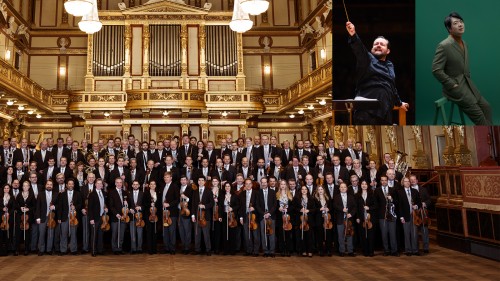
Vienna Philharmonic
Andris Nelsons, conductor
Stay in touch with Celebrity Series of Boston and get the latest.
Email Updates Sign up for Email Updates
